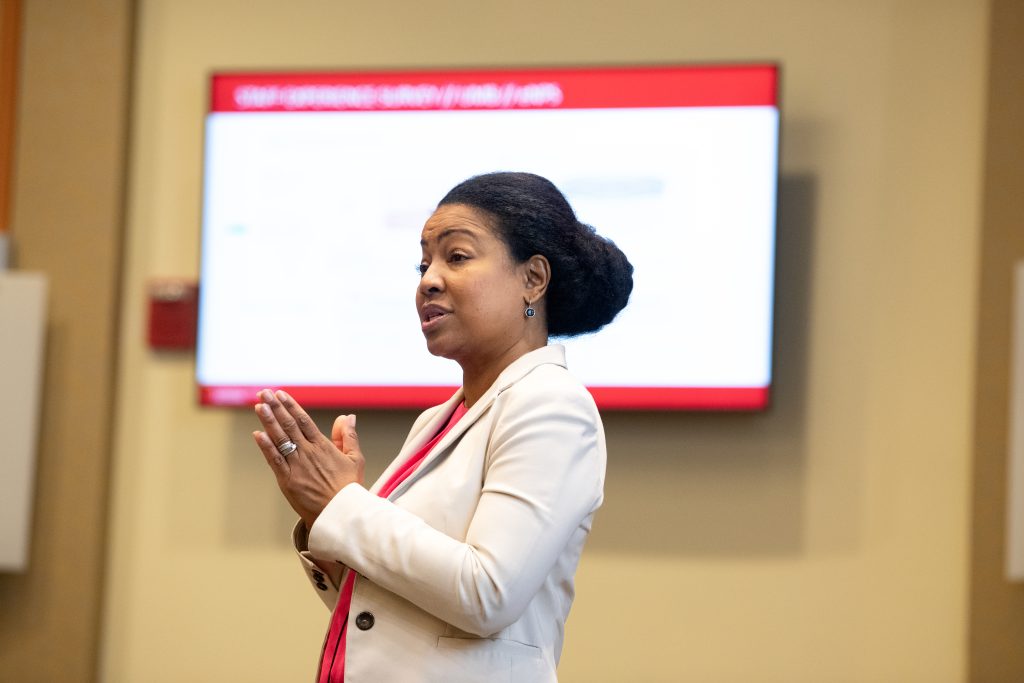
It’s one thing for an institution, business, or organization to say it is committed to advancing equity, diversity, and inclusion (EDI). It’s quite another for that entity to track its progress in a transparent way, but that is exactly what the University of Maryland, Baltimore (UMB) is doing with the launch of its EDI Data Dashboard.
The dashboard, a collaboration between the Office of Equity, Diversity, and Inclusion (OEDI) and the Center for Information Technology Services (CITS), is designed to be a dynamic tool for mapping and tracking the evolving landscape of EDI across UMB’s seven schools and central administrative units.
“We’re excited to launch the data analytics dashboard as a critical resource in assessing and advancing equity, diversity, and inclusion at UMB,” said Diane Forbes Berthoud, PhD, MA, the University’s chief EDI officer and vice president.
Creating this dashboard was among the priorities Forbes Berthoud laid out when she arrived in July 2021 as the University’s inaugural chief EDI officer. In announcing her hiring, UMB noted Forbes Berthoud “would design and operationalize a transparent accountability framework to measure and evaluate the impact and effectiveness of the University’s EDI initiatives at every level of the institution.”
Information that has already been publicly available in PDF form as PeopleSoft-generated employee reports on the Institutional Effectiveness, Strategic Planning, and Assessment (IESPA) website is now available in the Data Dashboard in an accessible, user-friendly platform. The first phase of the project includes data on staff and faculty presence, retention, and hiring, as well as faculty promotions and progressions.
OEDI and CITS are working on Phase 2 of the project, which will include student data related to enrollment, persistence, and retention. This dashboard is useful for those whose roles include understanding and advancing the state of EDI in their school or unit, and it also can be used by other stakeholders who are invested in EDI at UMB.
Forbes Berthoud says everyone at UMB stands to benefit from this tool. For example, hiring managers, leaders, deans, vice presidents, and administrators can use it to identify EDI gaps and opportunities to develop informed and innovative change and implementation strategies. Beyond leadership and decision-makers, grant writers can use the tool to report demographics in their proposals. OEDI will use the dashboard for improving EDI reporting and accountability across UMB to assist leaders in mapping, tracking, reporting, and improving EDI processes, outcomes, and representation in their schools or units.
“I look forward to working closely with our leadership colleagues to assess the EDI landscape in their schools and units and to partner with them to continue to drive measurable, sustainable, and systemic change,” Forbes Berthoud said.
The tool accentuates UMB’s strengths in EDI:
- Addressing historical underrepresentation, UMB has made substantial strides in gender equity, with women constituting 67 percent of the faculty and staff as of 2022.
- UMB was recognized with the 2023 Executive Alliance Honor Roll Award for advancing women’s representation, and the University’s progress is evident through its 15.5 percent increase in women holding executive, administrative, or managerial roles from 2012 to 2022. Women currently make up 66 percent of all executive, administrative, and managerial leadership, which includes deans and vice presidents.
- UMB was among the inaugural recipients of The Daily Record’s Empowering Women Awards, which recognize organizations in Maryland that show a strong commitment to supporting and elevating women.
- Over the past decade, UMB has experienced a steady increase in faculty and staff representation from the following populations: American Indian, Asian, Black/African American, Pacific Islander, or two or more races. UMB’s commitment to EDI was recognized two years in a row by Forbes magazine, which listed the University among America’s Best Employers for Diversity.
- Black/African American women comprised 76 percent of the executive, administrative, and managerial leadership.
- Black/African American women held 78 percent of the professional jobs with titles such as accountant, administrator, coordinator, and specialist. These professional roles can encompass responsibilities that call for the use of autonomy, discretion, creativity, and analytical thinking as well as contributions to the development of goals, objectives, and evaluations.
- The number of faculty and staff of color (American Indian, Asian, Black/African American, Pacific Islander, or two or more races) has steadily been increasing, growing from 38.9 percent in 2013 to 49.6 percent.
Forbes Berthoud says the dashboard will be continuously reviewed and revised, evolving as the EDI landscape changes. She notes that it strengthens the University’s alliance between data and progress, fulfills a significant commitment made in UMB’s Anti-Racism Statement, and reflects three of the University’s 2022-2026 Strategic Plan themes: Accountability and Integration of Core Values; University Culture, Engagement, and Belonging; and Innovation and Reimagination.
“The creation of this resource is a testament to UMB’s longstanding commitment to equity, diversity, and inclusion, as well as our focus on continued innovation and progress,” Forbes Berthoud said. “We’re able, through the various displays, to review trends, opportunities, and exemplars in order to facilitate effective strategic planning, implementation, and accountability.”
Check out UMB’s EDI Data Dashboard.



